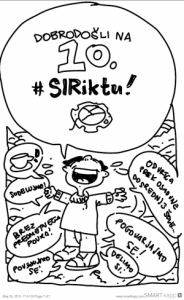Erika Grosar, Osnovna šola Solkan
I am going to present the idea of open learning in the framework of the international project Sliding to share. Learning has moved beyond the walls of the classrooms into the school neighbourhood and the hometown, and with the support of ICT it also made known our culture to the partners’ schools abroad. The project, in which pupils exchanged linguistic, cultural characteristics, music and art of own countries, brought together three schools from three EU countries. The project was held in parallel with official lessons and formed part of the teaching in a different way. It was not limited to the school subjects, timetable, days and it was not bound to the classroom and the school itself. The pupils took responsibility for their learning and product creation and the teacher became a mentor, coordinator and facilitator. Open learning was conducted in three phases. The first task was to plan and collect materials. In this part, the students made a plan on how and where to explore and deepen their knowledge of their school and town, and they distributed their roles in groups. They searched for the material in the library, among the local citizens and the World Wide Web. Next, the process of creation phase followed. They prepared the plan about what, where and how to create and what technology to use in the process (tablets, apps, Internet …). The teacher posted the products on the eTwinning portal, while for the students the materials were available in the Moodle. This learning environment enabled them unlimited access of the learning materials and products. Their parents were also involved. Our project Sliding to share spontaneously offered the opportunity to share and exchange products among partners’ schools. Students first introduced themselves to each other by means of a video, and then presented their school, the town and the country. They also created the project logo. The schools shared the project products on the eTwinning portal. In the final phase, the students received the partners products, which were available in the Moodle. Products were often viewed and studied at home. Students learned from them, commented and compared the data. They have developed a sensitivity for the identification and consideration of cross-cultural characteristics and deepened their respect for their own culture. Through the process described above, the students learned a lot from each other in an cross curricula way. They used mobile technology and became efficient searchers and users of certain information. They were motivated for the learning activities and took responsibility for their own learning. The teachers role was also important, as I continuously verified the learning objectives, and if necessary, I guided them through the appropriate activities.
